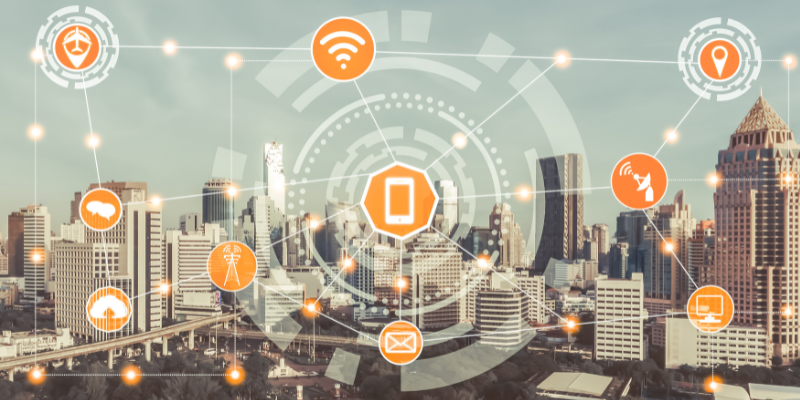7 Reasons for Enhancing RF Security in a Connected World
July 2024In today’s hyper-connected world, the reliance on wireless communication is more pronounced than ever. Radio frequency (RF) communications form the backbone of our modern infrastructure, from the proliferation of smart devices and the rollout of 5G networks to the critical operations of military and healthcare systems. However, with increasing dependency causes growing vulnerability to cyber threats. In this post, we discuss 7 reasons why bolstering RF security is a crucial element of national security, public safety, and economic stability.

1. Increased Use of Wireless Technologies:
- Proliferation of IoT Devices. The Internet of Things (IoT) has led to a massive increase in the number of connected devices, many of which communicate via RF. These devices often have limited security features, making them vulnerable to attacks. There are ways to secure IoT devices, including One effective RF technique to secure IoT devices is frequency hopping spread spectrum (FHSS).
- 5G Deployment. The rollout of 5G networks expands the use of RF communications in critical applications, including autonomous vehicles, smart cities, and industrial automation, increasing the potential impact of security breaches. One effective RF technique to secure 5G devices is massive MIMO (Multiple Input Multiple Output) combined with beamforming. Massive MIMO involves using a large number of antennas at the base station and on devices to improve communication performance, while beamforming is a technique that directs the transmission or reception of signals in specific directions rather than broadcasting them omnidirectionally.
1. Higher Stakes in Critical Infrastructure:
- Smart Grids and Utilities. Many critical infrastructure systems, such as power grids and water supply networks, rely on RF communication for monitoring and control. Compromising these systems can have severe consequences for public safety and national security.
- Healthcare. Medical devices, such as pacemakers and insulin pumps, often use RF for communication. Security breaches in these devices can have life-threatening implications. As with personal devices like smartphones and PCs, healthcare providers have adapted to security protocol such as digital certificates, multi-factor-authentication (MFA), and end-to-end encryption to name a few.

3. Increased Sophistication of Threats:
- Advanced Persistent Threats (APTs). An APT is a stealthy threat actor, typically a state or state-sponsored group, which gains unauthorized access to a computer network and remains undetected for an extended period.
- Wide Availability of Hacking Tools. Tools for intercepting, jamming, and spoofing RF signals are more accessible, making it easier for less sophisticated attackers to exploit vulnerabilities.
4. Technological Advancements:
- Quantum Computing Threats: The potential future development of quantum computers poses a significant threat to current encryption methods used in RF communications. .
- Edge Computing and AI: Edge computing is a distributed computing model that moves data storage and computation closer to the data’s sources. In a previous article, we defined artificial intelligence (AI) as any system or machine that is designed to imitate human intelligence, in order to perform tasks and improve upon itself using the increasing amount of information it collects. As edge computing and AI more integrated into RF systems, ensuring the security of these advanced technologies becomes critical to prevent sophisticated attacks.
5. Evolution of Wireless Applications:
- Military and Defense: Modern military operations rely heavily on RF communications for command, control, and situational awareness. Securing these communications is vital to maintaining operational effectiveness.
- Commercial Aviation: RF security is crucial in ensuring the safety and reliability of aviation communications, including navigation and air traffic control.

6. Regulatory and Compliance Pressures:
- Regulatory Requirements. Governments and regulatory bodies are increasingly mandating stricter security measures for RF communication systems to protect national security and consumer privacy.
- Industry Standards. Compliance with industry standards (e.g., NIST, GDPR) requires robust RF security measures, pushing organizations to enhance their security.
7. Economic Implications:
- Potential for Financial Losses. Security breaches in RF systems can lead to significant financial losses due to downtime, data breaches, as well as damage to an entity’s reputation.
- Insurance Costs: Companies may face higher insurance premiums if they do not adequately secure their RF communications, further driving the need for robust security measures.
The increasing reliance on RF communications across various sectors, coupled with the rising sophistication of threats and regulatory demands, creates critical need for enhanced RF security measures. Protecting these communications is essential to safeguard critical infrastructure, maintain public safety, ensure economic stability, and defend against both current and emerging threats. In the next post, we will talk further about RF security measures and techniques.
Latest Posts

5 Ways Physical Objects Affect RF Transmissions
In this post, we elaborate further on how physical objects can affect radiofrequency signal transmissions.

10 Factors that Affect Antenna Performance
We get a lot of inquiries regarding antenna performance in various settings, one of them being, “how far will the antenna propagate?” In this post, we describe some of the many factors that affect antenna performance.

Hedy Lamarr: The Hollywood Actress Who Changed Wireless Technology
This Women’s History Month, we wanted to highlight the life and career of Hedy Lamarr, a famous Hollywood star whose lesser-known achievements include essentially laying the foundations for the spectrum-hopping technology we know today as WiFi.

Living Legends: James West and Jesse Russell
Every February, JEM Engineering honors the the African American Engineers who have made lasting contributions in STEM. This year, we’re excited to spotlight two living legends: James Edward West and Jesse Eugene Russell.

11 Ways the Antenna Industry Has Changed
In this issue, we wanted to reflect upon how the antenna industry has evolved over the past several decades.
